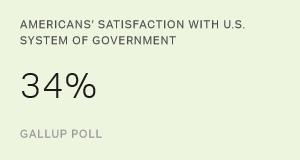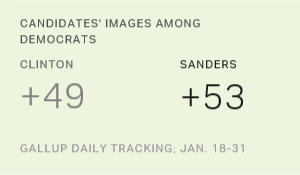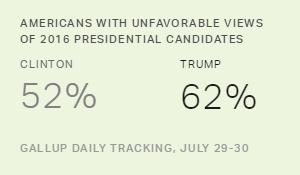Heading into Tuesday's New Hampshire primary voting, the biggest shift we are monitoring in Americans' big-picture look at the candidates comes among Democrats. Bernie Sanders' image is becoming more positive to Democrats across the country by the day, even as Hillary Clinton's sinks.
I'll get to the data in a moment, but the question in front of us is: Why are Democrats now looking at Clinton more negatively and Sanders more positively?
Sanders' more positive image began to be evident before what was interpreted as a strong showing in the Iowa caucuses, so that is not the major cause. The main answer must lie with what Democrats are hearing and seeing about the two in the news media (social or traditional), including the continuing focus on Clinton's emails while she was secretary of state, and Sanders' and Clinton's debate performances.
But there's a big cautionary note: Clinton's image among Democrats (and among all Americans if we go back in time) is extraordinarily labile -- meaning that it fluctuates. This past year alone, her net favorable among Democrats has gone from the +60s in the summer to as low as +46 in September, only to rise again in October and November and to fall again now to near her low for the year. Bottom line here: What goes up or down for Clinton can easily reverse itself.
Sanders' image has been somewhat more stable, but also subject to fluctuations. His net favorable score rose from the summer into September, then dropped in November, only to rise steadily to its current all-time high.
In the most recent three-week period, Clinton and Sanders have switched places. Interviewing ending Jan. 13 showed Clinton with a +57 net favorable rating among Democrats, and Sanders with a +47. Now, interviewing ending Feb. 6 shows Sanders with +57 and Clinton with +47.
Specifics: Clinton's favorable/unfavorable readings are now 71%/24%, while Sanders' are 67%/10%.
- Key #1: Sanders has much less baggage among Democrats, 10% negative vs. 24% negative for Clinton.
- Key #2: Sanders still has lower name ID, with 77% able to rate him, compared with a nearly universal 95% of Democrats who have an opinion about Clinton.
- Key #3: At one point last summer, only 45% of Democrats knew enough about Sanders to have an opinion.
- Key #4: If we factor out name ID, Sanders comes in with an 87%/13% positive-to-negative ratio, compared with Clinton's 75%/25%.
This last point is particularly relevant, given the differences in name ID between the two candidates. Since we began tracking in July, Clinton has averaged a 16-point higher net favorable score among Democrats than Sanders -- based on those who know the candidate. The two candidates' images have generally moved in tandem. During only two periods has the gap between them been significantly different from the overall average. The first was in the summer, when Clinton's quite positive image put her significantly above her average advantage. And now, Sanders actually has the lead over Clinton, a reversal of the usual state of affairs. Everything else being equal, a regression-to-the-mean scenario would predict that Clinton's image among Democrats will improve, while Sanders' will once again take a dip.
Sanders is from Vermont, the state forming most (but not all) of New Hampshire's western border. That contiguousness factor is widely expected to help him win in New Hampshire, as it did Sen. Paul Tsongas -- from Massachusetts, also a neighboring state -- who won in 1992.
On the GOP side, the major trends at the national level have been the deterioration in the images of Donald Trump and Ted Cruz over the last month or so.
These two candidates have been getting a lot of media focus, and quite obviously it hasn't been helping their images.
Cruz's image among Republicans has dropped by 18 points (net favorable) since about a month ago, and he is now at a net favorable of +30. Trump himself had a net favorable image of +30 less than three weeks ago, but his image has cratered to +17 among Republicans, close to his all-time low. Cruz still has the better image, but both men have seen Republicans become less and less positive about them.
The natural question is: Whose image has been improving concomitantly? The answer to that is Marco Rubio, whose image has been trending upward and who is now essentially tied with Ben Carson as the best-liked of any GOP candidate -- +44 for Carson, +42 for Rubio. Media consensus has coalesced around a negative review of Rubio's Saturday night debate performance in New Hampshire, so Republicans' views of him could suffer going forward.
Chris Christie's image has also been improving but, at +22, it is still less positive than Rubio's or Cruz's. Jeb Bush has come out of negative territory, but his net favorable score of +11 is still low. Carly Fiorina has been off the media and debate stage (she was excluded from Saturday night's GOP debate in New Hampshire), but her +25 net favorable reflects an upward trend. John Kasich's image is at +13, about on par with Bush's.
Kasich and Fiorina have severe name ID problems. Only 53% of Republicans are familiar enough with Kasich to have an opinion of the Ohio governor, and only 59% are familiar enough with former business executive Fiorina to have an opinion.
Trump and Bush are best known, with familiarity scores among Republicans of 95% and 89%, respectively, and with Christie, Cruz, Rubio and Carson all hovering at about 80% name ID.



